Critique of 'The Rabbit-Proof Fence' (2002) for EAL/D Learners
VerifiedAdded on 2023/06/07
|6
|885
|62
Report
AI Summary
This assignment provides a critique of the film 'The Rabbit-Proof Fence' (2002) by Phillip Noyce, evaluating its appropriateness and usefulness for learners for whom Standard Australian English (SAE) is not their primary language. The critique identifies the film as a symbol of female oppression among Aboriginal Torres Islanders, highlighting the harsh conditions and cultural biases depicted. The report suggests modifications to teaching activities, including simplifying vocabulary, using proper nouns, and avoiding complex sentences and indirect speech to enhance comprehension for EAL/D learners. The analysis emphasizes the importance of considering the linguistic needs of students when using the film in educational settings, and the need to support the learners with adapted resources and teaching approaches.
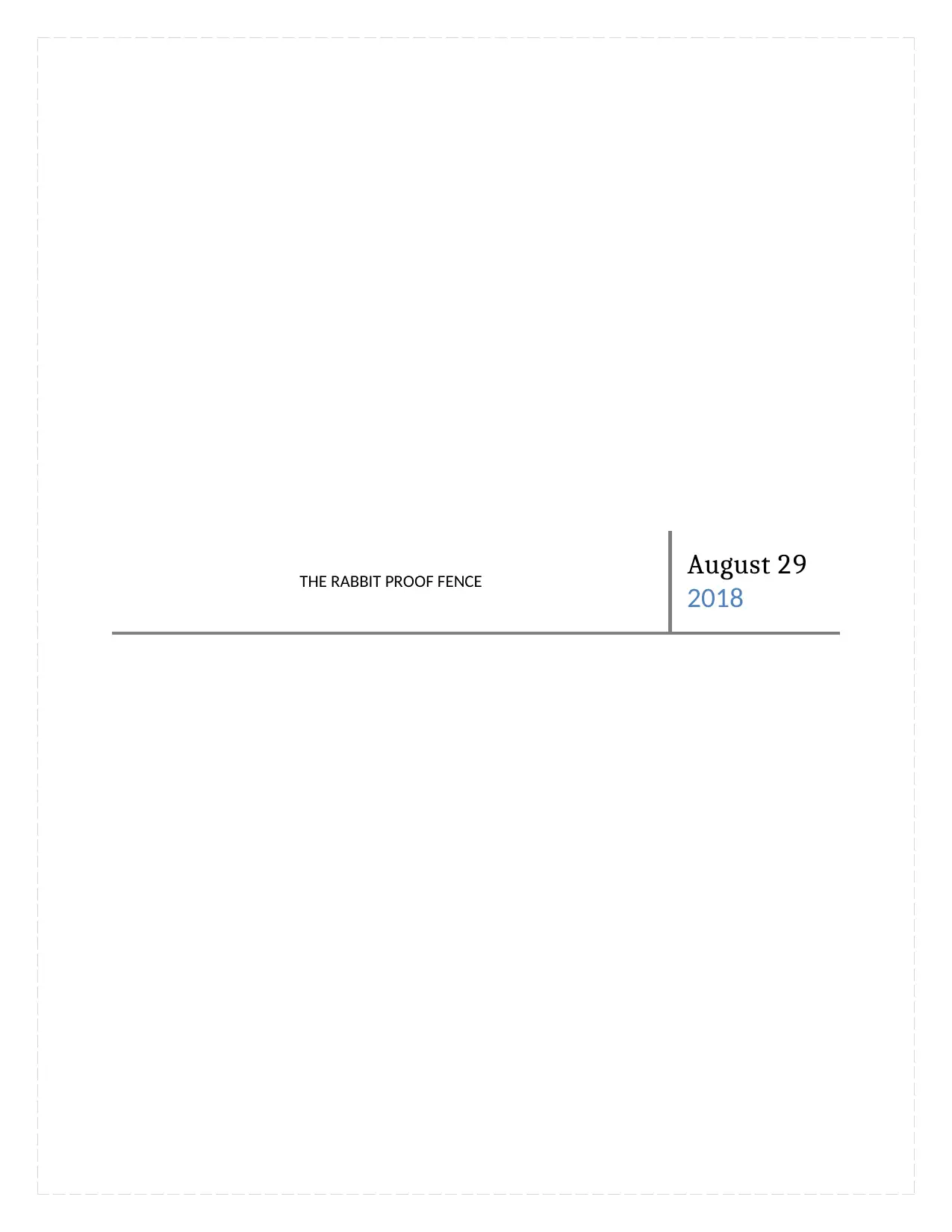
THE RABBIT PROOF FENCE August 29
2018
2018
Paraphrase This Document
Need a fresh take? Get an instant paraphrase of this document with our AI Paraphraser
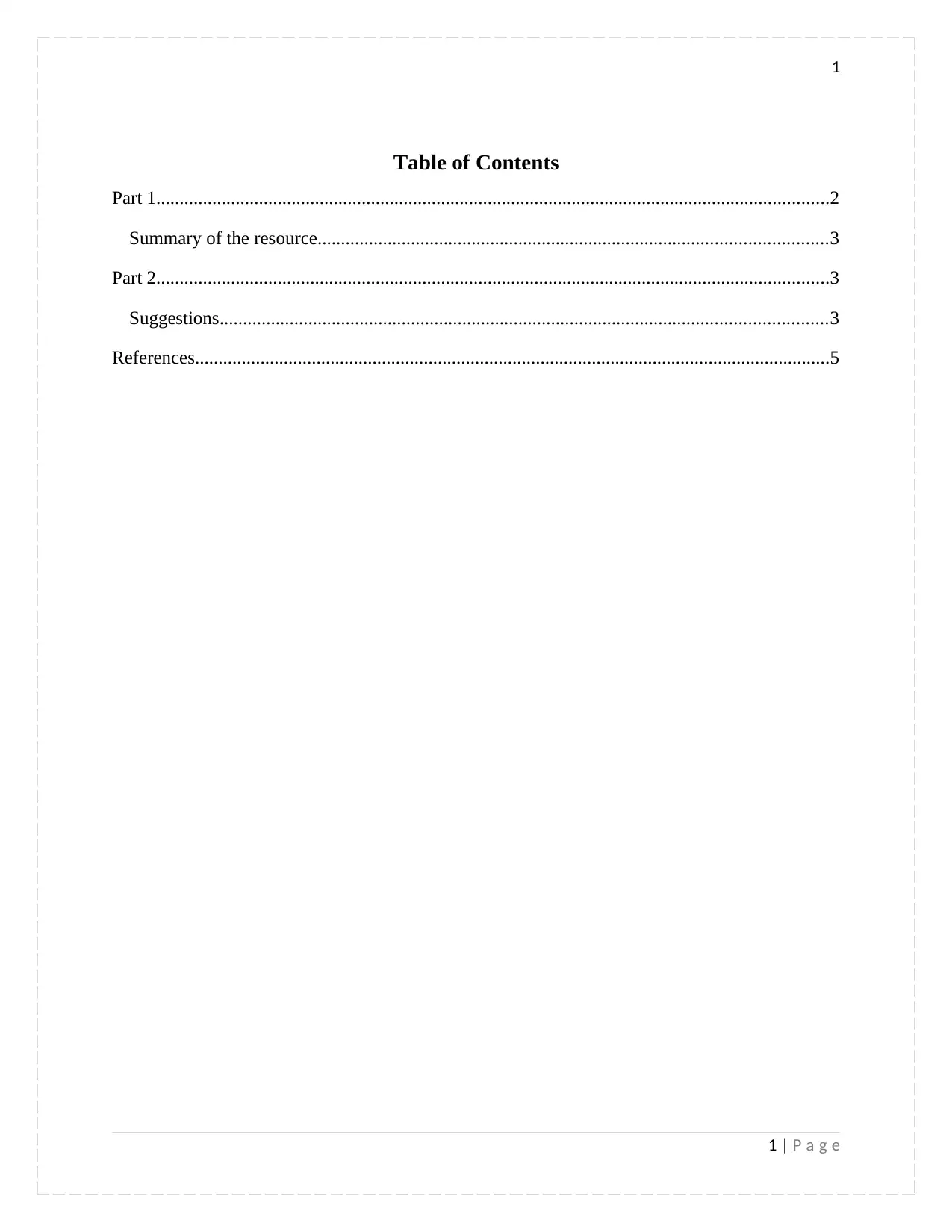
1
Table of Contents
Part 1................................................................................................................................................2
Summary of the resource.............................................................................................................3
Part 2................................................................................................................................................3
Suggestions..................................................................................................................................3
References........................................................................................................................................5
1 | P a g e
Table of Contents
Part 1................................................................................................................................................2
Summary of the resource.............................................................................................................3
Part 2................................................................................................................................................3
Suggestions..................................................................................................................................3
References........................................................................................................................................5
1 | P a g e
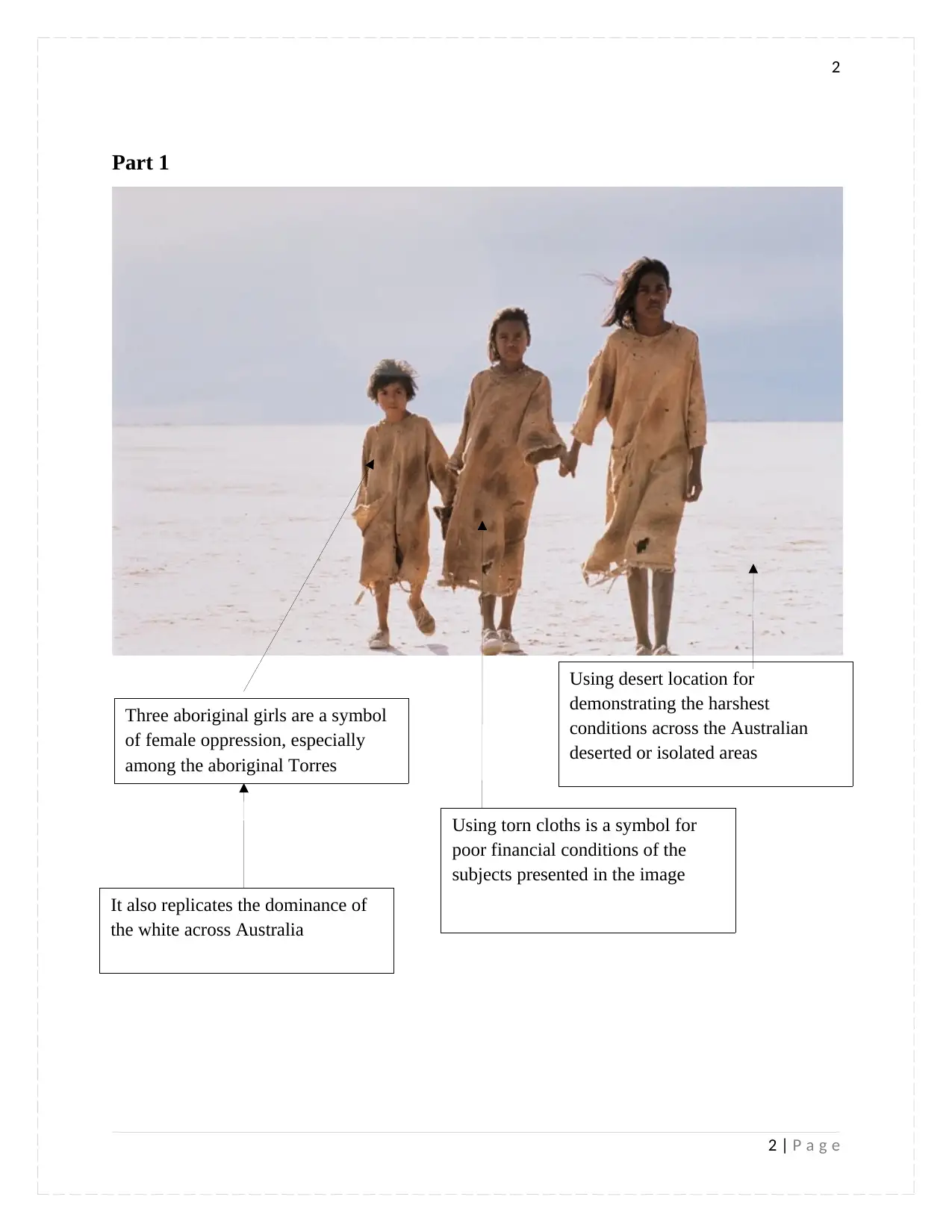
2
Part 1
2 | P a g e
Three aboriginal girls are a symbol
of female oppression, especially
among the aboriginal Torres
Islanders.
It also replicates the dominance of
the white across Australia
Using desert location for
demonstrating the harshest
conditions across the Australian
deserted or isolated areas
Using torn cloths is a symbol for
poor financial conditions of the
subjects presented in the image
Part 1
2 | P a g e
Three aboriginal girls are a symbol
of female oppression, especially
among the aboriginal Torres
Islanders.
It also replicates the dominance of
the white across Australia
Using desert location for
demonstrating the harshest
conditions across the Australian
deserted or isolated areas
Using torn cloths is a symbol for
poor financial conditions of the
subjects presented in the image
⊘ This is a preview!⊘
Do you want full access?
Subscribe today to unlock all pages.

Trusted by 1+ million students worldwide
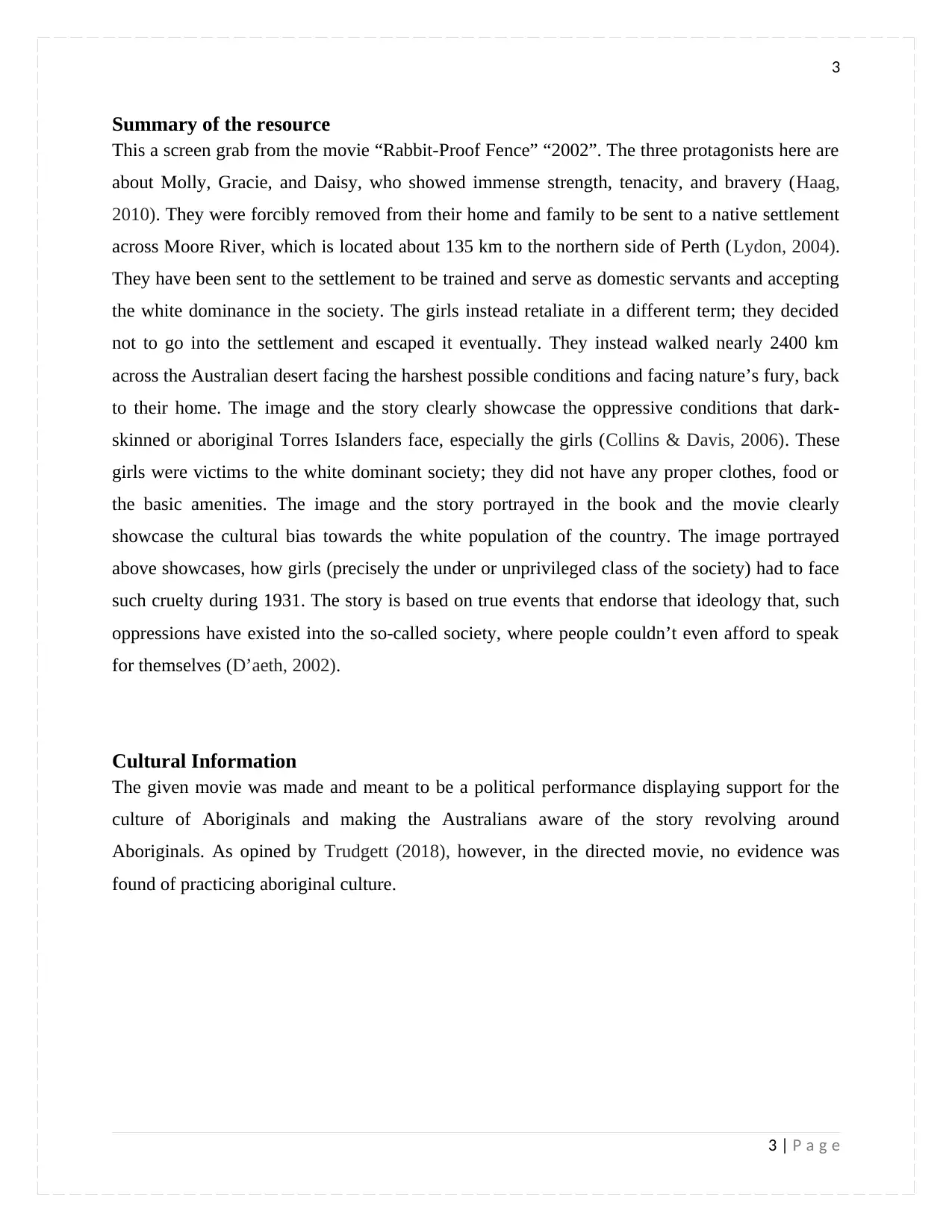
3
Summary of the resource
This a screen grab from the movie “Rabbit-Proof Fence” “2002”. The three protagonists here are
about Molly, Gracie, and Daisy, who showed immense strength, tenacity, and bravery (Haag,
2010). They were forcibly removed from their home and family to be sent to a native settlement
across Moore River, which is located about 135 km to the northern side of Perth (Lydon, 2004).
They have been sent to the settlement to be trained and serve as domestic servants and accepting
the white dominance in the society. The girls instead retaliate in a different term; they decided
not to go into the settlement and escaped it eventually. They instead walked nearly 2400 km
across the Australian desert facing the harshest possible conditions and facing nature’s fury, back
to their home. The image and the story clearly showcase the oppressive conditions that dark-
skinned or aboriginal Torres Islanders face, especially the girls (Collins & Davis, 2006). These
girls were victims to the white dominant society; they did not have any proper clothes, food or
the basic amenities. The image and the story portrayed in the book and the movie clearly
showcase the cultural bias towards the white population of the country. The image portrayed
above showcases, how girls (precisely the under or unprivileged class of the society) had to face
such cruelty during 1931. The story is based on true events that endorse that ideology that, such
oppressions have existed into the so-called society, where people couldn’t even afford to speak
for themselves (D’aeth, 2002).
Cultural Information
The given movie was made and meant to be a political performance displaying support for the
culture of Aboriginals and making the Australians aware of the story revolving around
Aboriginals. As opined by Trudgett (2018), however, in the directed movie, no evidence was
found of practicing aboriginal culture.
3 | P a g e
Summary of the resource
This a screen grab from the movie “Rabbit-Proof Fence” “2002”. The three protagonists here are
about Molly, Gracie, and Daisy, who showed immense strength, tenacity, and bravery (Haag,
2010). They were forcibly removed from their home and family to be sent to a native settlement
across Moore River, which is located about 135 km to the northern side of Perth (Lydon, 2004).
They have been sent to the settlement to be trained and serve as domestic servants and accepting
the white dominance in the society. The girls instead retaliate in a different term; they decided
not to go into the settlement and escaped it eventually. They instead walked nearly 2400 km
across the Australian desert facing the harshest possible conditions and facing nature’s fury, back
to their home. The image and the story clearly showcase the oppressive conditions that dark-
skinned or aboriginal Torres Islanders face, especially the girls (Collins & Davis, 2006). These
girls were victims to the white dominant society; they did not have any proper clothes, food or
the basic amenities. The image and the story portrayed in the book and the movie clearly
showcase the cultural bias towards the white population of the country. The image portrayed
above showcases, how girls (precisely the under or unprivileged class of the society) had to face
such cruelty during 1931. The story is based on true events that endorse that ideology that, such
oppressions have existed into the so-called society, where people couldn’t even afford to speak
for themselves (D’aeth, 2002).
Cultural Information
The given movie was made and meant to be a political performance displaying support for the
culture of Aboriginals and making the Australians aware of the story revolving around
Aboriginals. As opined by Trudgett (2018), however, in the directed movie, no evidence was
found of practicing aboriginal culture.
3 | P a g e
Paraphrase This Document
Need a fresh take? Get an instant paraphrase of this document with our AI Paraphraser
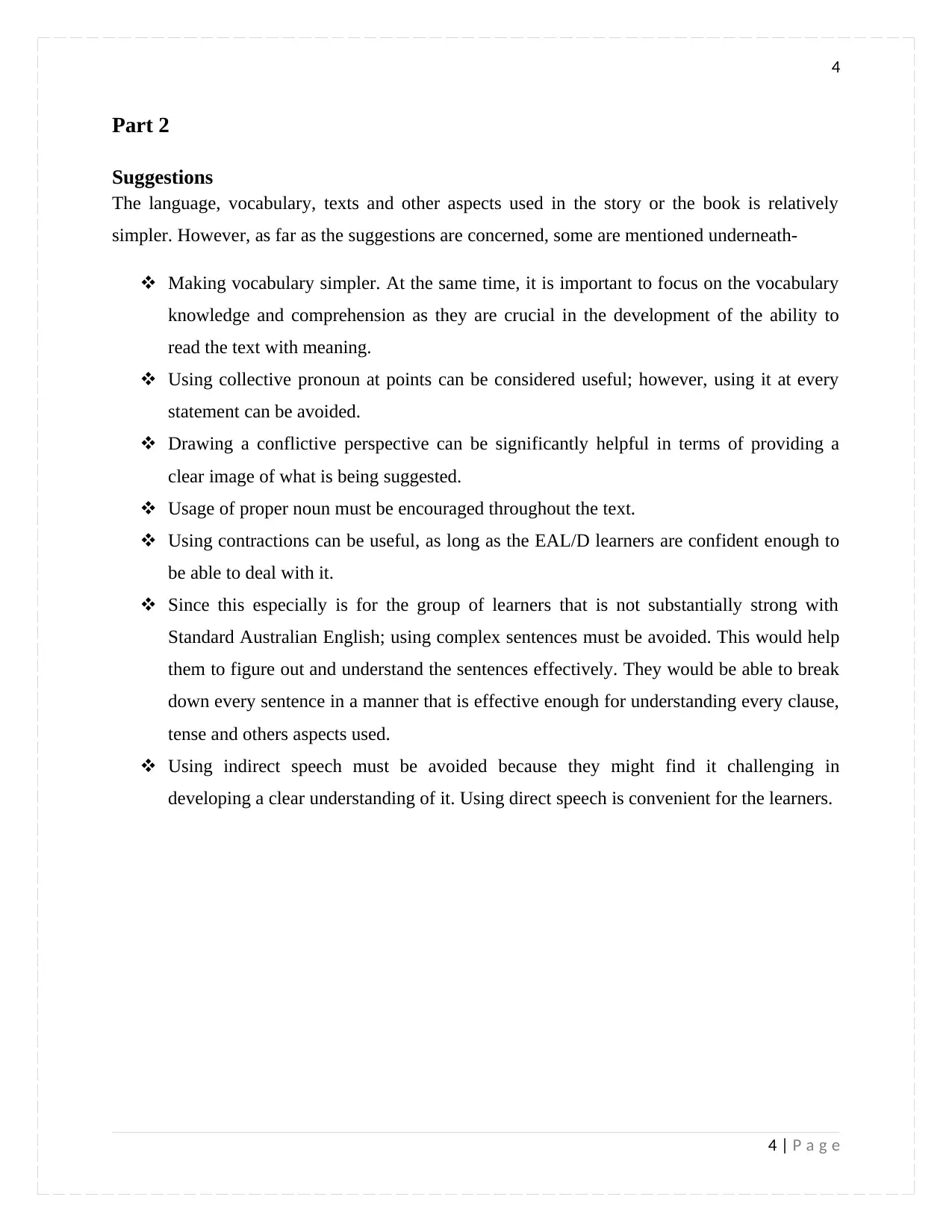
4
Part 2
Suggestions
The language, vocabulary, texts and other aspects used in the story or the book is relatively
simpler. However, as far as the suggestions are concerned, some are mentioned underneath-
Making vocabulary simpler. At the same time, it is important to focus on the vocabulary
knowledge and comprehension as they are crucial in the development of the ability to
read the text with meaning.
Using collective pronoun at points can be considered useful; however, using it at every
statement can be avoided.
Drawing a conflictive perspective can be significantly helpful in terms of providing a
clear image of what is being suggested.
Usage of proper noun must be encouraged throughout the text.
Using contractions can be useful, as long as the EAL/D learners are confident enough to
be able to deal with it.
Since this especially is for the group of learners that is not substantially strong with
Standard Australian English; using complex sentences must be avoided. This would help
them to figure out and understand the sentences effectively. They would be able to break
down every sentence in a manner that is effective enough for understanding every clause,
tense and others aspects used.
Using indirect speech must be avoided because they might find it challenging in
developing a clear understanding of it. Using direct speech is convenient for the learners.
4 | P a g e
Part 2
Suggestions
The language, vocabulary, texts and other aspects used in the story or the book is relatively
simpler. However, as far as the suggestions are concerned, some are mentioned underneath-
Making vocabulary simpler. At the same time, it is important to focus on the vocabulary
knowledge and comprehension as they are crucial in the development of the ability to
read the text with meaning.
Using collective pronoun at points can be considered useful; however, using it at every
statement can be avoided.
Drawing a conflictive perspective can be significantly helpful in terms of providing a
clear image of what is being suggested.
Usage of proper noun must be encouraged throughout the text.
Using contractions can be useful, as long as the EAL/D learners are confident enough to
be able to deal with it.
Since this especially is for the group of learners that is not substantially strong with
Standard Australian English; using complex sentences must be avoided. This would help
them to figure out and understand the sentences effectively. They would be able to break
down every sentence in a manner that is effective enough for understanding every clause,
tense and others aspects used.
Using indirect speech must be avoided because they might find it challenging in
developing a clear understanding of it. Using direct speech is convenient for the learners.
4 | P a g e
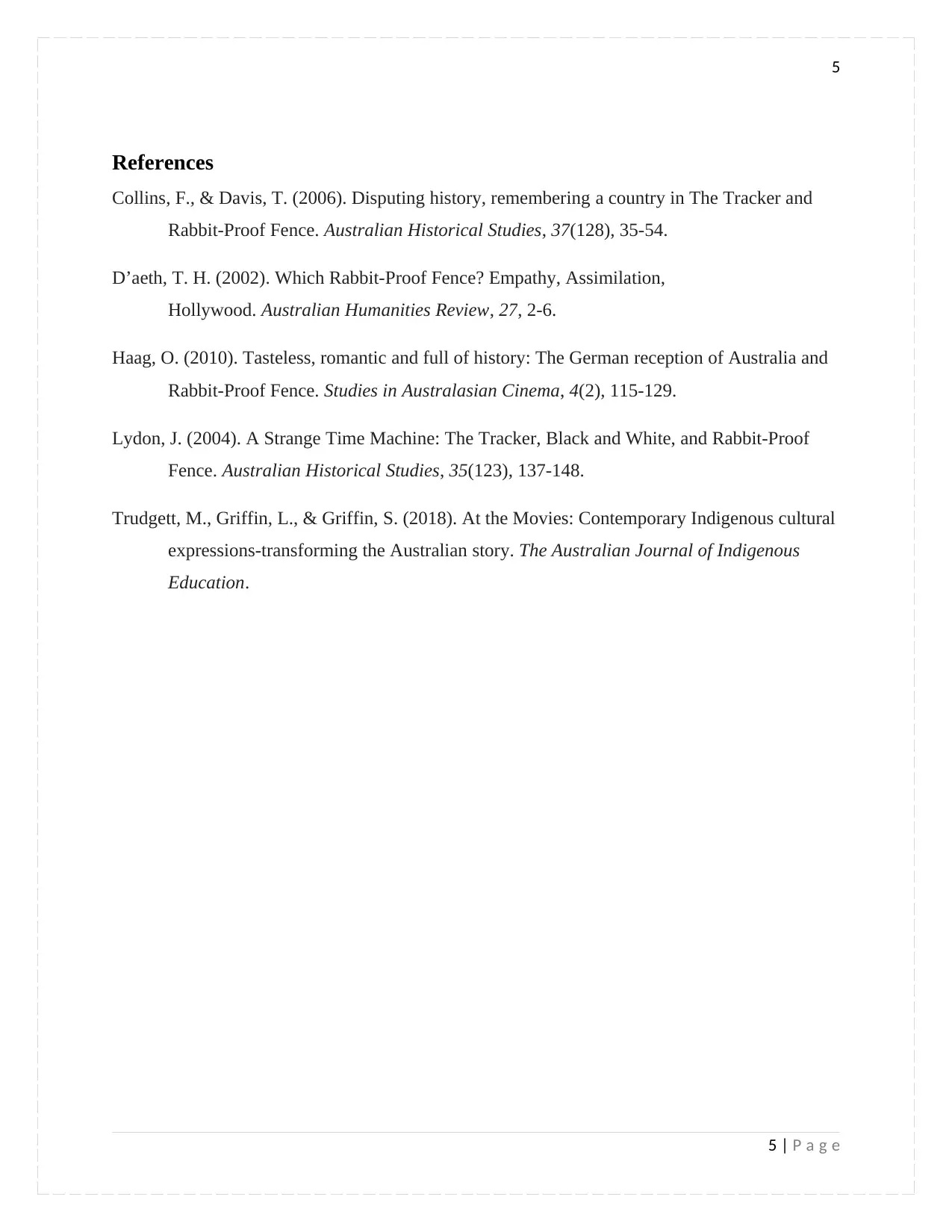
5
References
Collins, F., & Davis, T. (2006). Disputing history, remembering a country in The Tracker and
Rabbit‐Proof Fence. Australian Historical Studies, 37(128), 35-54.
D’aeth, T. H. (2002). Which Rabbit-Proof Fence? Empathy, Assimilation,
Hollywood. Australian Humanities Review, 27, 2-6.
Haag, O. (2010). Tasteless, romantic and full of history: The German reception of Australia and
Rabbit-Proof Fence. Studies in Australasian Cinema, 4(2), 115-129.
Lydon, J. (2004). A Strange Time Machine: The Tracker, Black and White, and Rabbit‐Proof
Fence. Australian Historical Studies, 35(123), 137-148.
Trudgett, M., Griffin, L., & Griffin, S. (2018). At the Movies: Contemporary Indigenous cultural
expressions-transforming the Australian story. The Australian Journal of Indigenous
Education.
5 | P a g e
References
Collins, F., & Davis, T. (2006). Disputing history, remembering a country in The Tracker and
Rabbit‐Proof Fence. Australian Historical Studies, 37(128), 35-54.
D’aeth, T. H. (2002). Which Rabbit-Proof Fence? Empathy, Assimilation,
Hollywood. Australian Humanities Review, 27, 2-6.
Haag, O. (2010). Tasteless, romantic and full of history: The German reception of Australia and
Rabbit-Proof Fence. Studies in Australasian Cinema, 4(2), 115-129.
Lydon, J. (2004). A Strange Time Machine: The Tracker, Black and White, and Rabbit‐Proof
Fence. Australian Historical Studies, 35(123), 137-148.
Trudgett, M., Griffin, L., & Griffin, S. (2018). At the Movies: Contemporary Indigenous cultural
expressions-transforming the Australian story. The Australian Journal of Indigenous
Education.
5 | P a g e
⊘ This is a preview!⊘
Do you want full access?
Subscribe today to unlock all pages.

Trusted by 1+ million students worldwide
1 out of 6
Your All-in-One AI-Powered Toolkit for Academic Success.
+13062052269
info@desklib.com
Available 24*7 on WhatsApp / Email
![[object Object]](/_next/static/media/star-bottom.7253800d.svg)
Unlock your academic potential
Copyright © 2020–2025 A2Z Services. All Rights Reserved. Developed and managed by ZUCOL.